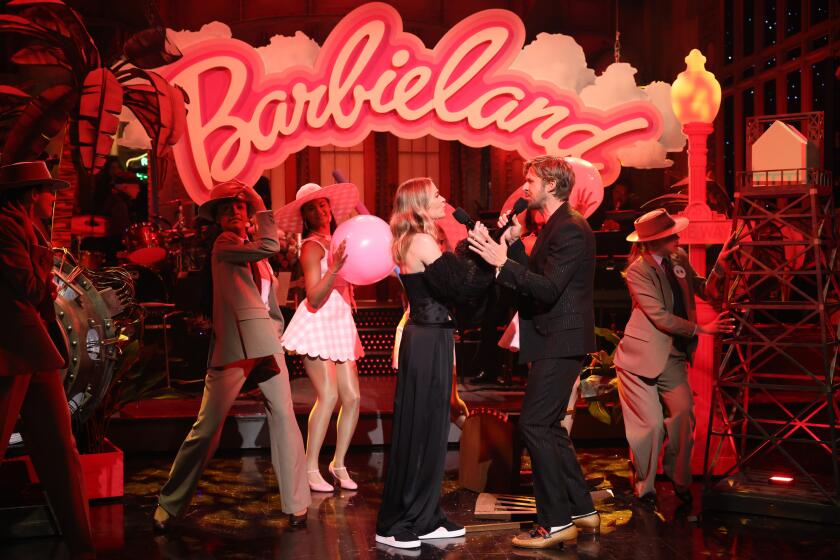‘Mad Men’ exhibit sheds light on Don Draper’s origins -- and future?
Attention, “Mad Men” fans: Ever wanted to peer into Don Draper’s box of secrets, or take a selfie in the Drapers’ Ossining kitchen? Starting on Saturday, you can.
That’s when an extensive new exhibit, “Matthew Weiner’s ‘Mad Men,’” will open at the Museum of the Moving Image in Astoria, Queens. The show, which runs through June 14, includes 33 costumes, two large-scale sets and hundreds of props from “Mad Men,” which begins its final, seven-episode run on April 5. It is one of numerous events planned at cultural institutions across the country commemorating the landmark series.
Fittingly for a program whose sumptuous look and meticulous period details have had a huge influence on fashion and interior design, the “Mad Men” exhibit is heavy on the visuals.
But for “Mad Men” obsessives -- this reporter included -- the most tantalizing items in the show may also be the least eye-catching. The exhibit opens with a section called “Origins” which focuses on the ideas and themes that shaped “Mad Men.” It includes three pages from Weiner’s journal circa 1992-93; excerpts from “The Horseshoe,” an incomplete screenplay by Weiner that inspired Don’s backstory; and notes jotted down on scraps of paper, including stationery from “The Sopranos.”
This being “Mad Men,” it’s incredibly tempting to pore over the material in search of clues about Don’s past -- and especially his future. With that in mind, here are a few details that caught our attention. Join us as we venture down the rabbit hole:
In a journal entry from 1992, Weiner sketches a character whose hard-drinking, sexually voracious habits make him sound a whole lot like Don Draper:
“My character has reached the end of a long circle which has been filled with spirals. He has fought his inner desires, to act on them would be suicide (he has fought this also) all the time embracing the promises of the post-Depression America. He is raised with hope and an almost arrogant belief that anything can be achieved. He is apathetic about history and politics and he doesn’t even follow money. For him the great pleasures of sex + alcohol (the latter usually to deaden the lack of the former) work into his decisions on everything. Sex is his out, booze is his tranquilizer which allows him to act on his desires and dampens the damage he does to others. He is capable of great cruelty, and his secret feelings -- the ones we deny -- will be revealed in action. He will be brave and cunning but he is ultimately scared because he runs from death and family -- for him they are the same.”
In another journal entry from January 1993, Weiner says he is 50 pages into the screenplay. At this point in the project, the protagonist is still just 12 years old, but Weiner is beginning to trace the major events and themes of his adult life:
“Now, my thoughts turn to his adult life. To the events that overlap in his adulthood. Surely if he leaves families they should have some [illegible] in his future. Take his long-lost brother, Adam. What becomes of him? His wife and daughter, then his second wife, already with children? His trip to Rome? California? Where do the pieces fall? ... I have firmly established a few themes 1) death that follows all men 2) men’s insatiable sexual proclivities 3) transience of family 4) need for an enemy 5) religious beliefs are transcended by desperate realities 6) time passes.”
The timeline for Weiner’s unnamed character ends in California in the 1980s:
Scrawled at the very bottom of Weiner’s 1993 journal entry is what appears to be a rough outline of the character’s life -- one that is sure to spark many theories about Don’s future. (Click here and scroll down to the middle of the page for a photo.) It seems to break down the character’s trajectory by decade and location, from Pennsylvania in the 1940s to Korea in the 1950s to “NY-wife-secretary-advertising” in the 1960s.
Sounds like someone we know, right? Well then consider what follows. In the ‘70s and ‘80s, Weiner lists Rome and California, respectively, as settings for his story. As fans know, both locations have already figured prominently in Don Draper’s personal life. Betty and Don took a trip to Rome as their marriage was falling apart, while Megan’s move to California precipitated the collapse of Don’s second marriage. Despite such associations, maybe he’s not done with either place? (Frankly the idea of ‘80s Don Draper living anywhere, much less California, is a little frightening.)
Don Draper started out as a blond guy named Pete:
The exhibit includes several pages from Weiner’s screenplay, “The Horseshoe.” Weiner told Rolling Stone in 2010 that the script was “”about this man who fabricated his life.” He wanted to follow the story “all the way to the millennium” but “crapped out around page 80,” he said. Years later, when Weiner was pitching “Mad Men” to AMC and trying to flesh out Don’s backstory, he went back to his notes and found “The Horseshoe.” “I didn’t even remember it existed,” Weiner recalled in 2007. “And I was like, ‘That’s who Don is.’ And once I figured out who Don was, I knew I had enough to get through the pitch meeting.” (In a nice coincidence, the screenplay ended in 1960, the very year in which “Mad Men” began.)
For what it’s worth, horseshoes are recurring symbols in “Mad Men.” In “5G,” Don’s long-lost brother Adam shows up at Sterling Cooper after seeing a photo of him in the newspaper receiving an industry award shaped like a golden horseshoe. And in a flashback in “Shut the Door. Have a Seat,” Don’s real father, Archibald Whitman, is kicked in the face by a horse and dies, the impact of the horseshoe leaving a bloody “U” shape in his cheek.
The screenplay pages on display at the Museum of the Moving Image include scenes that “Mad Men” fans will instantly recognize from the episode “Nixon Vs. Kennedy”: During the Korean War, two soldiers are caught in an accidental explosion; one of them dies, the other survives with injuries. Later on, the surviving soldier, having taken the dead man’s dog tags and assumed his identity, hides on a train as a flag-draped casket is delivered to his family. His kid brother spots him as the train pulls out of the station and calls out, but his family believes he’s just seeing things.
So how does this 20-plus-year-old version of the story differ from the one that ended up in “Mad Men”? In “The Horseshoe,” the character who switches identities is called Peter; the poor sap who dies is called Dick. On “Mad Men,” of course, it’s the real Don Draper who died, and the former Dick Whitman who assumed his identity.
Another difference? In Weiner’s original version of this scene, Dick and Peter are building a latrine and Dick’s body is “cut in half by a toilet seat.” (Yikes.) In “Nixon Vs. Kennedy,” the real Don is killed when Dick drops his cigarette lighter in a puddle of gasoline mistaken for urine.
But perhaps most shocking of all is the fact that Peter, the Don-esque character, is blond. On the train, he meets a beautiful woman (of course) who notices the last name on his uniform, “Agnelli” -- presumably poor old Dick’s last name -- and asks if he’s Italian. “Peter thinks for a moment,” the screenplay reads. “He runs his hands over his sandy, slicked-back hair.” (Let’s pause for a moment to allow you to absorb that possibility.)
The script also includes a character named Peggy, but it’s not that Peggy:
On pages 8 through 10 of “The Horseshoe” screenplay, Peter’s mother, a prostitute named Cora, dies giving birth to him. A midwife leaves the baby with a woman named Peggy Whitman, who is married to Peter’s father, Arch. Later, Peggy comforts Adam as Peter’s body -- which is really Dick’s -- arrives at the train station.
Follow @MeredithBlake on Twitter.
More to Read
The complete guide to home viewing
Get Screen Gab for everything about the TV shows and streaming movies everyone’s talking about.
You may occasionally receive promotional content from the Los Angeles Times.






